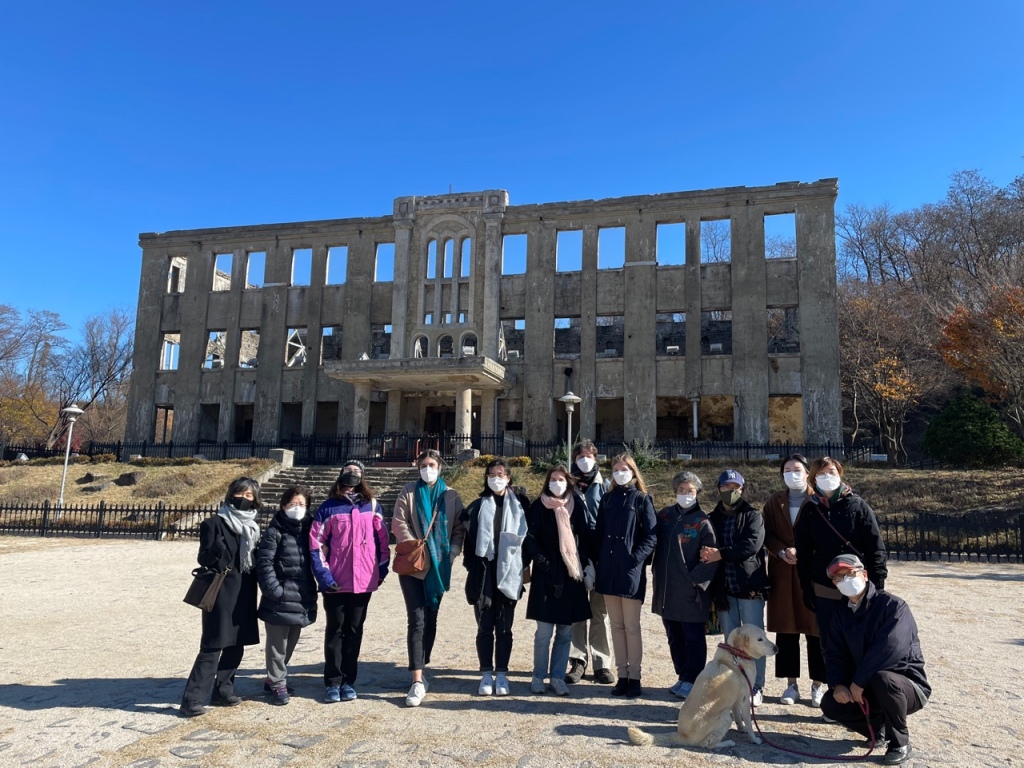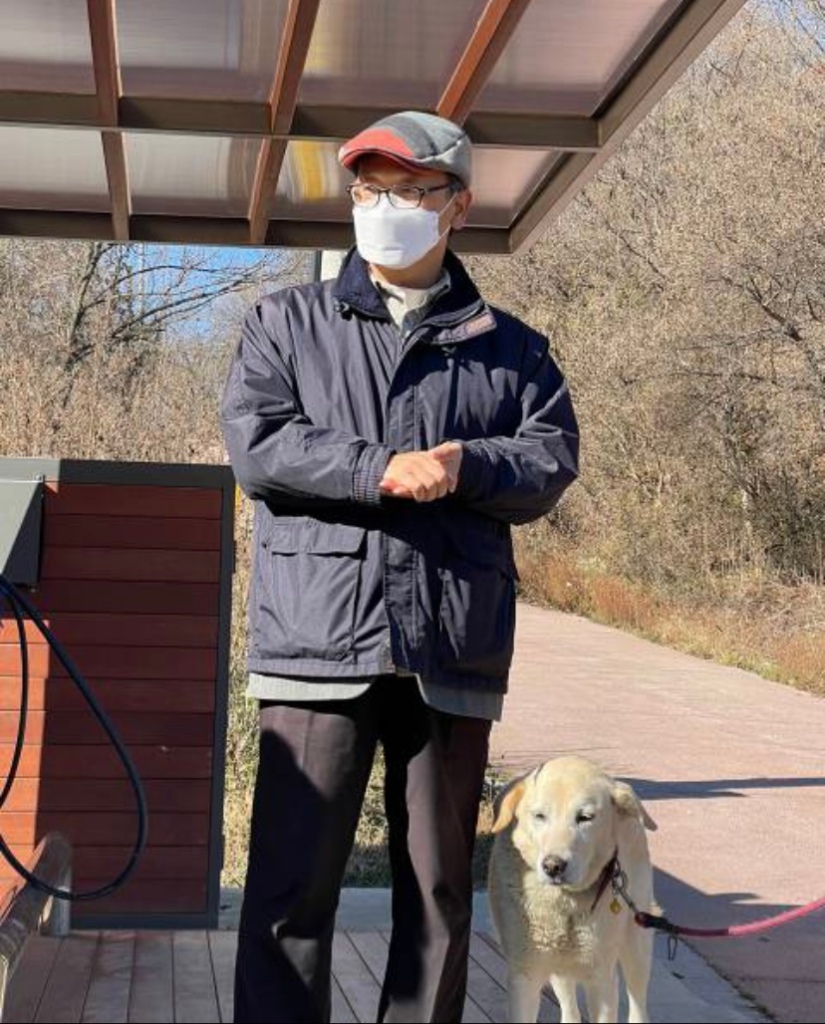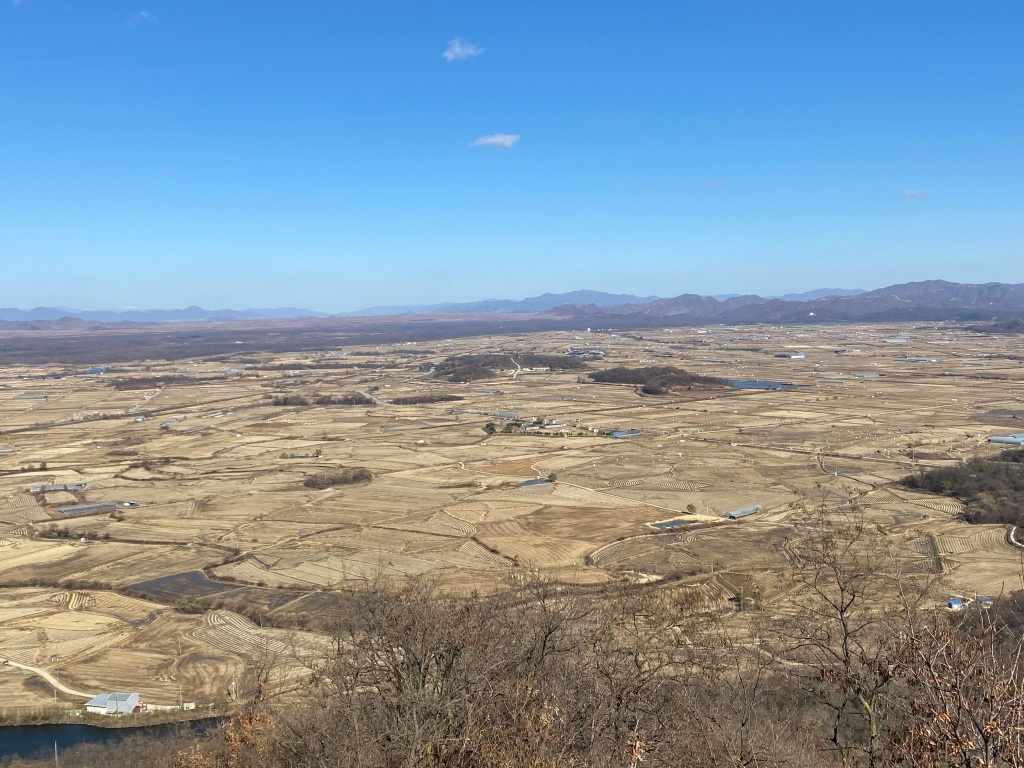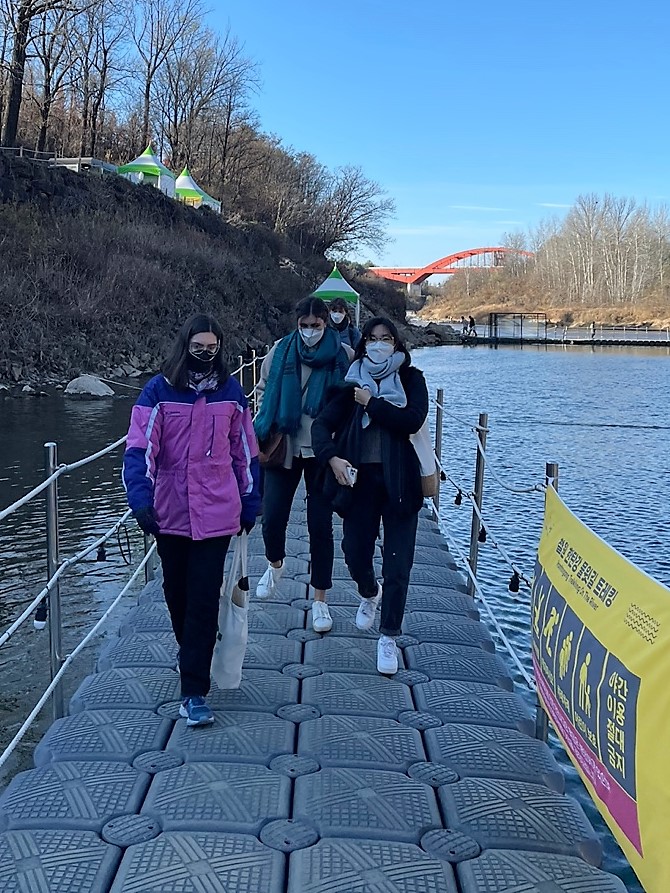Due to COVID restrictions, we were unable to visit the DMZ and Border Peace School located near the DMZ. The school focuses on 1) a one-year educational program teaching peace, 2) the Festival of Peace and the Peoples Peace Movement, and 3) international work via exchange speakers from Korea and Washington, DC. The school is comprised of 10 adult learners from different backgrounds with a shared goal of unifying the two Koreas. Since we couldn’t visit the school, the leaders provided a full day of activities for us.
A group of mission workers and ministers (from PCUSA, YAVs, National Council of Churches in Korea, and Global Ministries) drove to Cheorwon, a border town near the DMZ and the 38th parallel. Upon arrival, we waited at a monument (a bombed-out building left over from the war) for our guide from the Peace School. A peacekeeper from Cheorwon, who walks this mountain everyday with his dog, joined us. We hiked up 1200 steps, walking in silence. I felt God’s presence with me as I walked up the mountain and prayed for peace for the Korean people on both sides of the DMZ. Many people have participated in this peace journey and prayed for a unified Korea. When I finally got to the top of the mountain, out of breath and panting, I looked up and out onto beautiful fields – surely God was present in that quiet, peaceful place. After reading about the military presence at the DMZ, I didn’t expect Cheorwan to be as quiet and peaceful as it was. On the mountain top I was not worried about my safety. Looking into North Korea, we could see empty fields. We were told the land is too dry and desolate to grow rice in the north. However, in South Korea they grow over 70,000 tons of rice a year, and the water which allows them to grow rice so well, comes directly from the north. At the summit, we stood in solidarity and prayed for the reunification of the people of Korea.








After our hike, we all went to a restaurant in town for lunch. We ate the “lifesaving Tofu”, named by the owner who said this tofu cured his cancer. We had fried tofu and tofu in a stew with mushrooms, spinach, scallions, and beans – I will say it was the freshest and most delicious tofu I have ever eaten!




After lunch, we walked across floating platforms in the Hantangang River GeoPark. Then we went to Hantangang Sky Bridge, which was designed to resemble a crane, because cranes migrate to Cheorwon to winter over every year. When we sat in a café for a debriefing, we were lucky enough to see some cranes. It was nice to talk about this shared experience because I had such conflicting thoughts going into this day – I expected a heavy military presence but instead, it was quite peaceful.








We toured the 5-acre Peace Tree Farm which focuses on biodynamic farming. We got out of the van and were greeted by an enthusiastic golden retriever, providing some much-needed doggie kisses. We attended a lecture about organic farming and learned that the farm grows 60 different crops. They raise cows, goats, chickens, and bees. They sell cow and goat milk and yogurt at their store; however, their most popular product is tomato juice, which sells out immediately. The farm was a great escape from the hustle and bustle of the city life – I could stay here for a week!





A bit of history – Korea was occupied by Japan in 1905, after the Russo-Japanese War. Then in 1910, Japan annexed Korea. Historically, this was a bad time for Koreans, as the Japanese exploited, abused, and tortured many Koreans. In 1945, the United States liberated Korea and the Koreans were very grateful to be free from Japan. At the end of World War II, the Soviet Union and the United States divided the Korean peninsula approximately in half, at the 38th parallel. Unfortunately, Koreans were not really involved in this decision. A communist government was set up north of 38 degrees latitude and the United States supported a non-communist military in the south. Then on June 25, 1950, the Korean war broke out when North Korea invaded South Korea. Over 2 million people were killed. On July 27, 1953, the war ended in a cease fire, not a resolution. The Korean Armistice Agreement was a military document signed by (1) US Army Lt. General William K. Harrison, Jr., senior delegate, United Nations Command Delegation and (2) North Korean General Nam II, senior delegate, Delegation of the Korean People’s Army and the Chinese People’s Volunteers. One of the conditions of the Armistice Agreement was that opposing military forces and equipment would each pull back 2 kilometers from the 38th parallel, creating a “demilitarized zone”, running 240 kilometers across the width of the Korean peninsula and splitting it in half north to south. The DMZ was meant to be a buffer zone between the armies of North Korea and South Korea.
There are two sides to every story – the Korean Conflict and the Cold War that I studied in history class did not present the Korean side of the story. Because the cease fire agreement was signed by an American general representing the United Nations Command, South Korea was not in control of the situation. Since Eisenhower was President, the US has been in control of the South Korean military and has never signed an official Peace Treaty to end the Korean War. I recognize that international relationships are complicated, but it seems that multiple government agencies and policies may be making it more difficult for the Korean people to live in peace. On July 1, 2017, the US announced a travel ban to North Korea, effective September 1, 2017. The ban will expire August 31, 2022 unless it is extended by the Secretary of State. This travel ban prevents organizations providing humanitarian aid to the people in North Korea. It also prevents families in South Korea from visiting family members in North Korea. Before the Covid pandemic, Presbyterian church leaders in South Korea communicated and visited leaders in North Korea, despite their opposing governments. Communication is vital for Koreans, on both sides of the DMZ, to coexist peacefully.
Thanks, Grace, for taking us on your tour and giving us a bit of Korean history. You’re a good commentator!
Mac McKay.
LikeLiked by 1 person